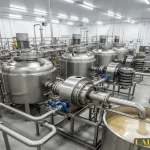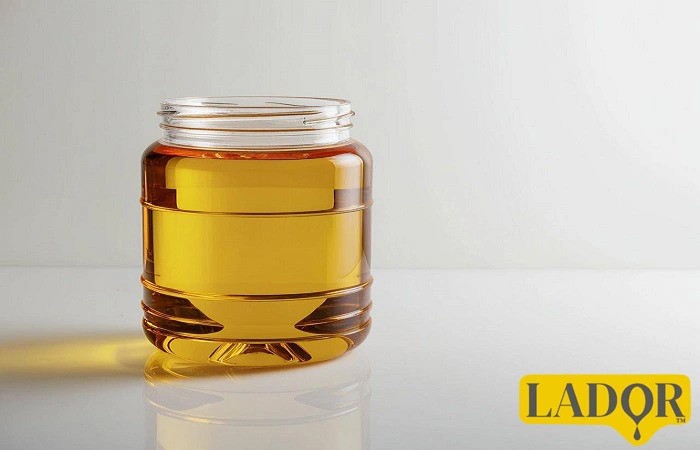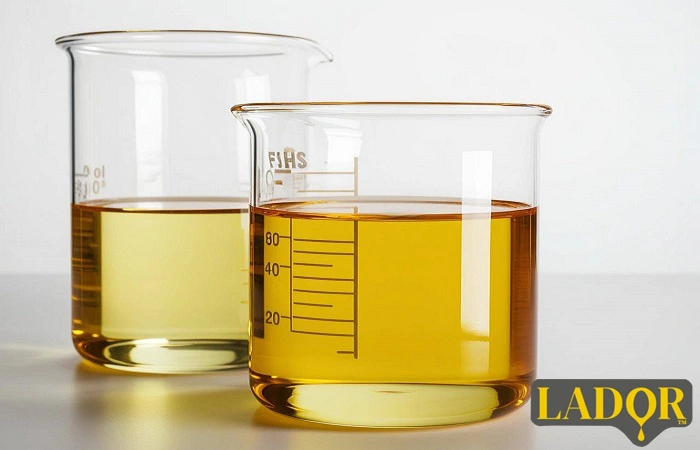

Palm oil is one of the most widely consumed vegetable oils globally. Due to its unique characteristics, in addition to extensive applications in the food industry, it has become a critical component in the animal and poultry feed industry and other industrial sectors. This oil, extracted from the fruit of the oil palm tree, is used as a rich and sustainable energy source in feed rations and a valuable raw material in various products. Join us in this article from Ladorfat for a detailed review of palm oil.
Palm oil is derived from the fleshy part of the fruit of the oil palm tree (Elaeis guineensis). The fruit resembles a large, orange date. Due to its specific fatty acid composition, it is semi-solid or solid at room temperature.
This oil is divided into two main types:
Extracted from the fruit pulp (mesocarp), which contains approximately 50% saturated fatty acids (mainly palmitic acid).
Extracted from the fruit kernel (seed), where the saturation level reaches over 80% (mainly lauric acid), and it has different properties.
Note: Crude Palm Oil (CPO) is reddish-orange due to its high beta-carotene content (a source of Vitamin A), but after refining (for food and industrial uses), it becomes white or colorless.
The production of palm oil involves the following steps:
After harvest, the fresh fruit bunches are sterilized with hot steam to halt the activity of enzymes that cause spoilage.
The fruits are separated from the stalk, soaked, and cooked.
The cooked fruits are pressed under pressure to extract the Crude Palm Oil (CPO) from the fleshy cells of the fruit.
Crude Palm Oil contains water and impurities. The oil is allowed to settle in large tanks for separation and clarification. It is then refined through processes such as neutralization, bleaching (carotenoid removal), and deodorization to obtain Refined Palm Oil, suitable for human consumption, animal feed, or industrial uses.
To enhance usability in animal rations, refined palm oil is converted into a low-moisture palm fat powder, an extremely rich energy source, through a spray-drying process.
Palm oil is mainly composed of triglycerides. The approximate fatty acid composition in refined palm oil (the conventional type derived from the fruit pulp) is as follows:

Due to its chemical composition and physical properties, palm oil has many advantages in various applications:
Because of its high percentage of saturated fatty acids, palm oil has excellent resistance to oxidation (rancidity) and heat. This stability ensures that products containing it have a longer shelf life.
Palm oil is a very high-calorie and rich source of energy. This feature makes it a crucial additive in the feed of high-producing livestock and poultry to optimally meet the animal’s high metabolic requirements.
Compared to many other vegetable oils, palm oil is cost-effective and, with its high production yield per unit area, is very suitable for mass industrial production.
The semi-solid state of palm oil at room temperature provides it with specific texturizing and structural stability features, which are highly important in the production of products such as margarine, chocolate, and pelleted animal feed.
Palm oil is used in the following various industries:
The application of palm oil and its derivatives in various industries is as follows:

In Iran, palm oil with a high saturated fatty acid percentage (sometimes above 19%) that is imported for animal/poultry feed or industrial use, has unfortunately sometimes been used illegally in the production of certain food products (such as some high-fat dairy products) due to its low cost and suitable physical properties, leading to serious health complications for humans. However, its legal use in cosmetic, health, and other chemical industries is a common and accepted practice.
In Iran, companies are active in the production and supply of palm oil derivatives for animal and poultry feed. Ala Oil Sepahan Company, with the trade name Lador is one of the recognized producers in this field. Focusing on the needs of the livestock and poultry industry, this company has proceeded to produce various high-quality animal and poultry fats.
Among the specialized products of Ladorfat, managed by Mr. Said Alaee, are 30-35% Palm Fat Powder, Omega-3 Fat Powder, special poultry oils, Tallow oil, Sunflower oil, animal Soybean oil, Hydrogenated Poultry Oil, and countless other products. Ala Oil Sepahan Company, by utilizing modern technology and the supervision of nutrition specialists, plays an important role in improving performance and production efficiency in the country’s livestock farms and poultry houses.
Palm oil is one of the most widely used vegetable oils globally due to its stable chemical composition, excellent thermal stability, cost-effectiveness, and rich energy content. Its importance in the livestock and poultry industries, especially in providing energy for high-yield rations, is undeniable. For price inquiries and information, please contact the experts at Ladorfat.